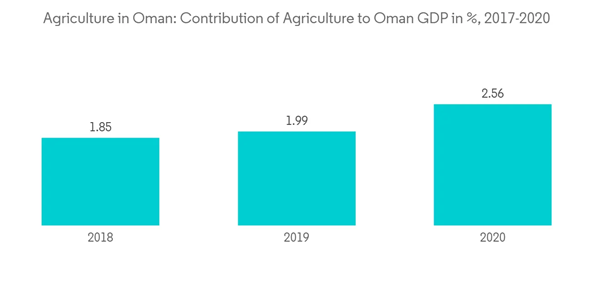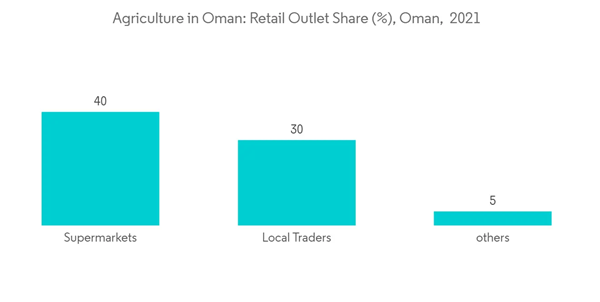The Agriculture in Oman Market size is estimated at USD 2.24 billion in 2024, and is expected to reach USD 3.01 billion by 2029, growing at a CAGR of 6.16% during the forecast period (2024-2029).
Furthermore, to install contemporary irrigation systems in gardens, the country's agricultural Ministry offers monetary and synthetic loans, Exempting businesses from paying income tax on projects involving agricultural output. The exemption is valid for five years following the production date and may be extended for an additional five years. The government offers loans to customers willing to finance greenhouses, modern irrigation systems, agricultural tractors, agricultural nurseries, date factories, and any other project or service within the agricultural sector in the country. These factors are increasing the agricultural contribution to the GDP of the country. For instance, according to world bank statistics, the contribution of agriculture to Oman's GDP has increased from 1.98 in 2017 to 2.56 in 2020. Therefore, the increase in government initiatives to support the agricultural sector in the country is expected to boost the growth of the agriculture market.
The increasing presence of major retailers and supermarkets and their aggressive import strategies result in better access to many fruits and vegetables for the Omani population at comparatively cheaper rates. For instance, In 2017, Lulu Hypermarkets alone imported 65 ton of vegetables and bananas to Oman to increase the availability of agricultural produce in the local markets. In 2021, The LuLu Hypermarket Oman opened a new store in Jalan Bani Bu Ali in the South Sharqiya Governorate. This new store will further strengthen the group's presence in the country. It will offer customers a new level of standard in price, convenience, comfort, quality in-store service levels, and a new shopping experience.
Oman Investment Authority announced a new project to market vegetables and fruits in the country under the newly incorporated company Oman Food Investment Holding Company. Under this project, retail outlets are likely to be established in densely populated cities. In addition, SPAR opened a new store in the Ghala business district in Muscat in 2020 as a part of its expansion strategy. This SPAR Supermarket has a total retail sales area of 710 sq. m. and was designed in collaboration with SPAR International. The outlet is dedicated to fresh agricultural products like fruits and vegetables, fish, and meat, among other categories.
Thus, the increase in urbanization rates and hypermarkets have also triggered the demand for high-value processed agricultural foods. Moreover, convenient logistics service provided by retail chains is changing the consumer demand patterns in the market studied in Oman. Hence, the changing retail structure may influence consumer shopping behavior, likely boosting the agriculture market over the forecast period.
This product will be delivered within 2 business days.
Key Highlights
- The increase in the adoption of advanced farming technologies and conducive government policies supporting domestic crop production are some factors driving the country's market growth. Through imports, Oman meets its domestic fruits, vegetables, and cereals demand. Therefore, to reduce import dependency, the country aims for self-sufficiency in agricultural products by encouraging its farmers to adopt advanced farming techniques.
- Agricultural production in Oman consists mainly of dates, vegetables, and fruits, while other crops are cultivated at lesser volumes. According to world bank statistics, the total amount of agricultural land in Oman was about 1.4 million hectares in 2020, which accounted for 4.7% of the total land area. Fruits like bananas and papaya are also grown in coastal regions, which accounted for 18,447 ton and 5,840 ton of production, respectively, in 2020. Additionally, Oman increased its barley, sorghum, and wheat production in recent years.
- Moreover, the government launched several initiatives to encourage private sector production, such as updating regulations, providing low-interest loans, aiding domestic production, and running campaigns to increase the visibility of locally made products, which is expected to boost the growth of agriculture in Oman during the forecast period.
Oman Agriculture Market Trends
Government policies of the country to reduce import dependency
Some of the reasons propelling the market expansion in the nation include the rise in the adoption of cutting-edge farming technologies and favorable government policies promoting local crop production. The majority of Oman's local need for fruits, vegetables, and cereals is satisfied by imports. Therefore, the nation is working toward agricultural self-sufficiency by encouraging its farmers to use cutting-edge farming methods in order to decrease import dependency. According to the Official Oman eGovernment Services Portal, to attract more agricultural investments, concerned parties in the government provide many incentives. For instance, if the agricultural project is located in the governorate of Muscat (except Quriyat), Oman Development Bank will lend up to 100% of the capital. Approximately 130% of the capital paid is supplied if the project is constructed outside of the Quriyat or Muscat governorates.Furthermore, to install contemporary irrigation systems in gardens, the country's agricultural Ministry offers monetary and synthetic loans, Exempting businesses from paying income tax on projects involving agricultural output. The exemption is valid for five years following the production date and may be extended for an additional five years. The government offers loans to customers willing to finance greenhouses, modern irrigation systems, agricultural tractors, agricultural nurseries, date factories, and any other project or service within the agricultural sector in the country. These factors are increasing the agricultural contribution to the GDP of the country. For instance, according to world bank statistics, the contribution of agriculture to Oman's GDP has increased from 1.98 in 2017 to 2.56 in 2020. Therefore, the increase in government initiatives to support the agricultural sector in the country is expected to boost the growth of the agriculture market.
Well established Retail networks are supporting growth of agriculture in the country
The distribution network and retail chains relating to agriculture are expanding consistently in Oman. The Omani retail industry is characterized by strong consumer demand, robust economic growth, distinct demographic factors, and a high-end technology system that ensures better customer service and efficient customer checks.The increasing presence of major retailers and supermarkets and their aggressive import strategies result in better access to many fruits and vegetables for the Omani population at comparatively cheaper rates. For instance, In 2017, Lulu Hypermarkets alone imported 65 ton of vegetables and bananas to Oman to increase the availability of agricultural produce in the local markets. In 2021, The LuLu Hypermarket Oman opened a new store in Jalan Bani Bu Ali in the South Sharqiya Governorate. This new store will further strengthen the group's presence in the country. It will offer customers a new level of standard in price, convenience, comfort, quality in-store service levels, and a new shopping experience.
Oman Investment Authority announced a new project to market vegetables and fruits in the country under the newly incorporated company Oman Food Investment Holding Company. Under this project, retail outlets are likely to be established in densely populated cities. In addition, SPAR opened a new store in the Ghala business district in Muscat in 2020 as a part of its expansion strategy. This SPAR Supermarket has a total retail sales area of 710 sq. m. and was designed in collaboration with SPAR International. The outlet is dedicated to fresh agricultural products like fruits and vegetables, fish, and meat, among other categories.
Thus, the increase in urbanization rates and hypermarkets have also triggered the demand for high-value processed agricultural foods. Moreover, convenient logistics service provided by retail chains is changing the consumer demand patterns in the market studied in Oman. Hence, the changing retail structure may influence consumer shopping behavior, likely boosting the agriculture market over the forecast period.
Oman Agriculture Industry Overview
Additional Benefits:
- The market estimate (ME) sheet in Excel format
- 3 months of analyst support
This product will be delivered within 2 business days.
Table of Contents
1 INTRODUCTION
4 MARKET DYNAMICS
5 MARKET SEGMENTATION
6 INTERNATIONAL TRADE AND PRICE SCENARIOS
7 REGIONAL ANALYSIS
8 COMPETITIVE ANALYSIS
Methodology

LOADING...










